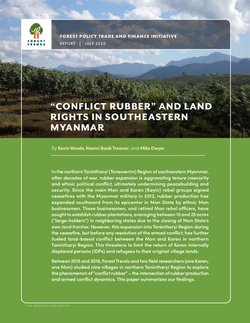MRLG| 30 July 2020
“Conflict rubber” and land rights in southeastern Myanmar
After decades of war, in northern Tanintharyi Region, rubber expansion is further aggravating tenure security and reviving historical grievances between Mon and Karen communities, ultimately undermining prospects for peacebuilding and security. This has implications for other interests in the region, and comes at a time when the Myanmar government is positioning rubber as a strategic crop for export and global buyers are simultaneously looking for new suppliers and implementing their own responsible sourcing commitments.
Key findings of this Forest Trends’ case study include: 1) Rubber expansion in northern Tanintharyi demonstrates that “land grabbing” and dispossession can result from smaller-scale crop production, in addition to large-scale agricultural investment; 2) By locking in private land use ownership in former Karen villages, where communities were forced off their lands during a previous counterinsurgency, Mon “large-holders” are making it impossible for Karen communities to return to their customary lands; 3) This land conflict undermines the possibility for reconciliation and has preempted attempts at land restitution.
See the full report here https://www.mrlg.org/wp-content/uploads/2020/08/Forest-Trends-Conflict-Rubber-and-Land-Rights-in-SE-Myanmar.pdf
“Conflict rubber” and land rights in southeastern Myanmar
After decades of war, in northern Tanintharyi Region, rubber expansion is further aggravating tenure security and reviving historical grievances between Mon and Karen communities, ultimately undermining prospects for peacebuilding and security. This has implications for other interests in the region, and comes at a time when the Myanmar government is positioning rubber as a strategic crop for export and global buyers are simultaneously looking for new suppliers and implementing their own responsible sourcing commitments.
Key findings of this Forest Trends’ case study include: 1) Rubber expansion in northern Tanintharyi demonstrates that “land grabbing” and dispossession can result from smaller-scale crop production, in addition to large-scale agricultural investment; 2) By locking in private land use ownership in former Karen villages, where communities were forced off their lands during a previous counterinsurgency, Mon “large-holders” are making it impossible for Karen communities to return to their customary lands; 3) This land conflict undermines the possibility for reconciliation and has preempted attempts at land restitution.
See the full report here https://www.mrlg.org/wp-content/uploads/2020/08/Forest-Trends-Conflict-Rubber-and-Land-Rights-in-SE-Myanmar.pdf












